Cards In This Set
| Front | Back |
 Piazza d'italia |
Charles Moore, (New Orleans, LA), 1975-78. neo-conservative architecture, turns around from reductive, pure modern arch, lots of colors, ornamentation, decoration, uses neoclassical elements like columns
|
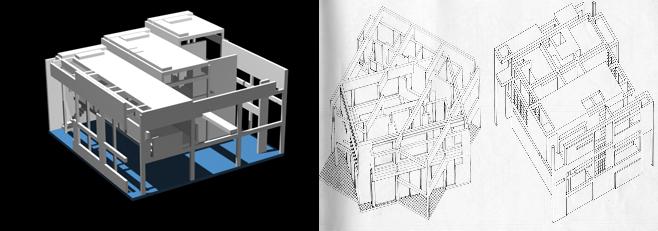 Axonometric Drawings forHouse |
Peter Eisenman, 1968-71. post-structuralist, modernism didn't go far enough, too quickly absorbed in mainstream, conceived of square plan, epitome of rectangularity, engaged w/ purity of cube, generate forms out of it, opens possibilities to conventional notions of space
|
 Decorated shed |
Robert Venturi and Denise Scott Brown 1972. architecture itself as part of sign system, arch aspires to be the duck but they embrace dec shed as more relevant way to think about arch. just need the snazzy sign "i am", building behind less significant. based off visit to vegas strip, legitimate and relatively inexpensive response to modern conditions, had more relevance to the present world than the costly contortions of the modernist monuments.
|
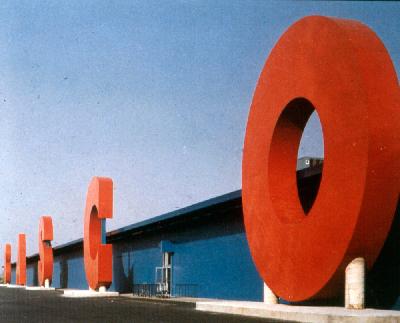 BASCO Showroom |
Robert Venturi and Denise Scott Brown, (Bristol Township, PA), 1971. arch should be thought of as communicative, sign system, what you need for arch: shed and really good sign
|
 Exile |
Julian Schnabel, 1980. large painting/collage, horns stick out, composition, copies caravaggio's figure, colors, pictorial field is frame where other styles/images collide, no centering, compositional logic, pure expression produces inconsistencies, meaning lessens, neo-conservative
|
 Maria Callas No. 2, |
Julian Schnabel, 1982. spontaneity returns in '80s, neo-expressionist, "unplanned" brushstrokes
|
 Landscape with Two Nudes and Three Eyes |
David Salle, 1986. no cognitive map, post mod is era of schizophrenia, inability to have existent realities. juxtaposes iconography, objects, styles, and techniques from the antipodal extremes of high and low art, appropriates an historical masterpiece of art by the Dutch master, Meindert Hobbema, with a picture of a nude woman in a provocative pose.
|
 Felix on a Pedestal |
Kenny Scharf, 1982. mainstream always interested in non-mainstream, airbrush, cartoon-y, hallucinatory fantasies
|
 Drawing in NYC subway station |
Keith Haring, 1982. child like, doodles, not refined, simple, graffiti is assertion of individual in dominant codes, these codes don't speak for u so have to insert your own
|
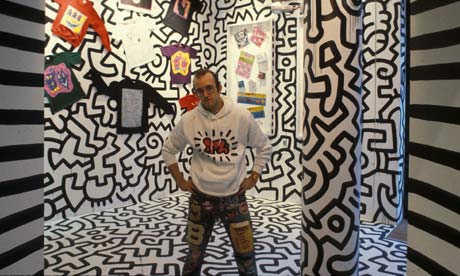 Pop Shop installation |
Keith Haring, 1986. takes to commercial level, saw as less than store, more gallery, re-created in 2009 at tate modern,
|
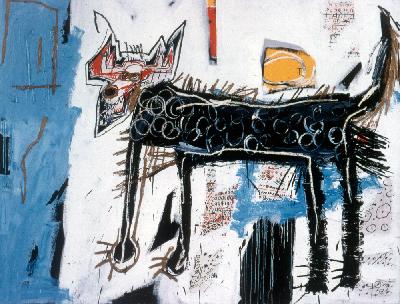 Part Wolf |
Jean-Michel Basquiat, 1982. brings low art to high art, downtown culture to uptown, mystique due to convergence of certain primitivist fantasies by white ppl, otherworldly figure, child-like, savage like producer of spontaneous, authentic expression. in its delivery of primitivist expression, raw, post-mod critics: wildness and artist as prim constructs position where viewer is cultured and stable, reassure self of difference of space, lets them be affirmed of their taste, conservative in a way, doesn't make you feel uncertain, consolidate your position and you're more economically powerful, hierarchy of power
|
 Time square show |
Colab 1980. street art gallery shows, music, art, youth, anti pop, this eventually becomes cool by the masses though, multitude of ppl, looked for venues, exhibition as guerilla action, no commitment to becoming institution, money love and death room, nonhierarchical, youthful, aggressive, those not repped in art world showcased here ie blacks, women, etc
|
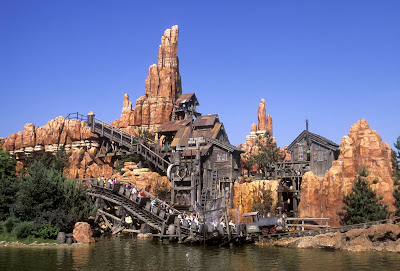 Frontierland |
Eurodisney, signs like mickey mouse become real entities, sub reality, disneyland replica of real place? maybe small town? but where? taps into nostalgic fantasy of small town life, thematization of spaces, SIMULACRUM
|
 Marilyn Diptych |
Andy Warhol, 1962; Gene Korman, 1953 publicity still of Marilyn Monroe for Niagara, used by Warhol. copy of a copy, but photo is a copy of reality
|
|
Warhol's marilyn diptych�ssss Marilyn Monroe Diptych,
|
(Elaine) Sturtevant, 1972. can't tell it apart from original, yet original is much more valuable in market, we put values on them, but really they're the same. esp confusing because warhol's was a copy too, where's the original from which these copies emerge? SIMULACRUM
|



